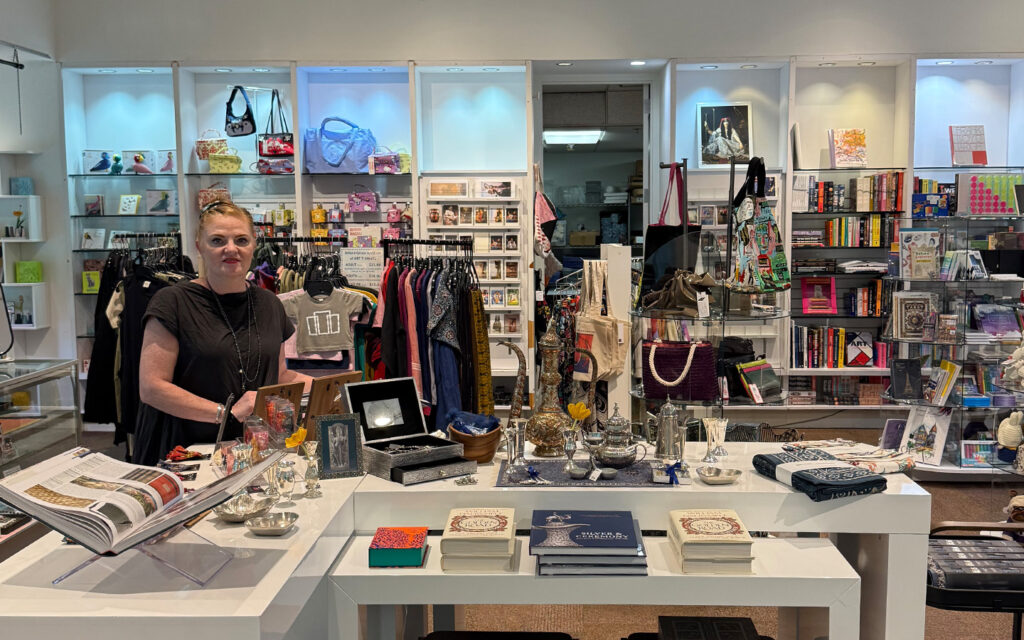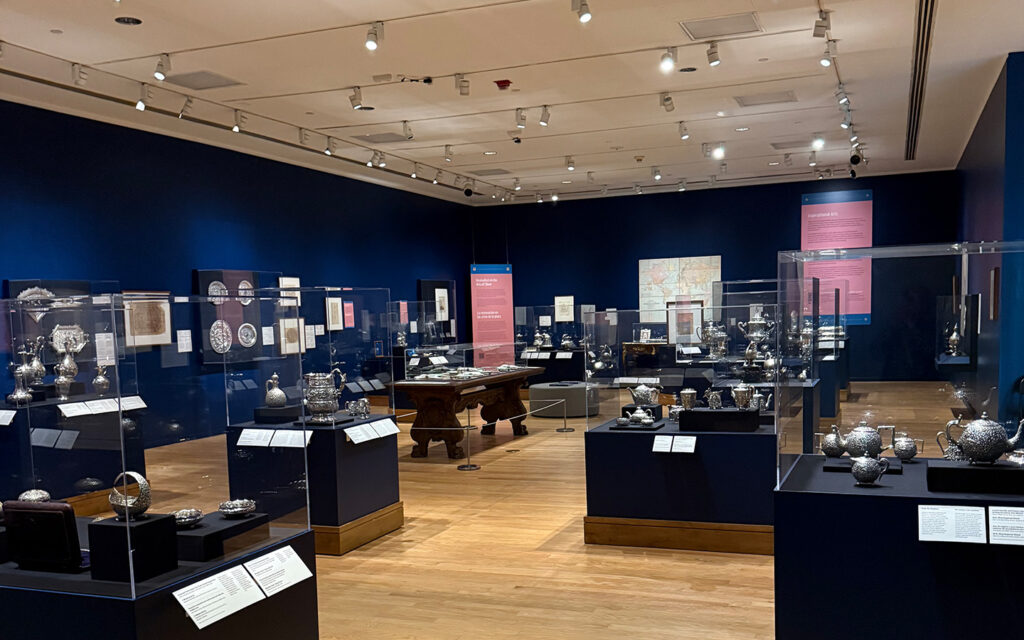 Back to Resources
Back to Resources
No matter where you travel — from world-leading museums in London, Paris, and New York to small and mid-sized museums closer to home, you’ll discover museum gift shops packed full of unique items you can purchase to commemorate your visit.
Personally, I have a fantastic collection of art museum books, eclectic art pieces, and various tchotchkes that remind me of my experiences at special locations across Europe and the US. Gift shops are a fantastic way for visitors to remember their trip, but they’re equally great for museums, provided your organization understands the key to running a financially successful gift shop.

In this overview, we’ll share several best practices that organizations should adopt to run a successful museum gift shop. Throughout, we’ll feature tips from our arts and culture nonprofit accounting professionals and share the perspective of a real expert: Sophie Cosper, Museum Shop Manager at the Birmingham Museum of Art.
The Role of a Museum Gift Shop
Gift shops should serve as an extension of the museum, offering products that represent the exhibits guests have spent the last couple of hours enjoying. Many high-profile museums view their stores as an extension of the learning experience, emphasizing the themes of an exhibition and providing interested visitors with additional learning materials to continue their journey at home. In many ways, a gift shop is the final exhibit of the museum tour.
Run well, gift shops can make significant contributions to a museum’s revenue, sometimes accounting for as much as a quarter of the organization’s total income. The Museum Store Association, a group for retail stores at cultural institutions, reports annual gift shop net sales as high as $8.2 million for some members. And this income plays a vital role in helping to fund the wider institution, with all of the gift shop’s profits flowing directly to the museum itself.
Having a well-run, financially successful gift shop is key to the longevity and success of many of our most venerable cultural institutions. But what does it take to manage a successful museum gift shop? Let’s turn our attention to answering that question.

Planning for Financial Success: 5 Strategies to Make Your Shop Thrive
For museum gift shops to thrive, they must implement a series of well-thought-out financial strategies. For the best results, run the gift shop like the business it is and provide a great experience for visitors while maximizing financial performance.
Here are some recommendations, key financial metrics, and financial strategies that will help you run your museum gift shop more efficiently than ever.
1. Cater Inventory to Visitor Preferences
For any organization to be successful, it’s vital that you truly understand your customers. By understanding visitors’ shopping habits, preferences, and interests, museums can curate a selection of products that closely matches what their visitors want.
There are several steps that museums can take to curate an appropriate selection of products. Conducting surveys and gathering feedback from museum visitors helps museums gauge their visitors’ shopping habits, preferences, and interests. Studying customer demographics and buying trends can also influence inventory selection. For instance, if your museum gets a lot of school trips full of younger shoppers with a small budget, make sure you have plenty of fun, low-cost items for them.
It’s also important to closely match your inventory to the museum itself. Gift shops should offer products that relate to the exhibitions and the museum’s overall mission. This includes art reproductions, books, unique souvenirs, and educational materials that align with current themes or the featured artists in the museum. This doesn’t just make sense from the perspective of serving your visitors; it’s also important for tax reasons, as we’ll explain later.
Institutions that are free to the public have additional considerations that gift shop managers have to consider. Sophie explains:
“In one sense, institutions with free entry need to offer things that anyone can afford, and on the other hand, a lot of people want to spend more in the shop to support the museum because they didn’t have to pay to get in.”
— Sophie Cosper, Museum Shop Manager at the Birmingham Museum of Art
Regardless of the type of museum you run, some items are universally popular. Products like books, tote bags, postcards, mugs, printed silk scarves, and magnets are tried-and-tested favorites and are always a great representation of the museum. Local artisans whose creations align with the theme of the museum are always popular too.
2. Invest in Marketing the Gift Shop (And Don’t Overlook E-commerce)
Often, museum tours end in the gift shop. Your visitors have to walk through the gift shop to leave, but in an ideal world, that shouldn’t be the first time they hear about what your gift shop has to offer.
Marketing the shop within the museum and online ensures that museum guests are excited to visit your gift shop at the end of their tour. Marketing strategies like the use of social media, local advertising, and partnerships with local businesses all help drive traffic to the shop.
In addition to in-store sales, consider establishing an online shop. Leveraging e-commerce platforms gives your shop a much broader reach, enabling customers who may not visit the museum in person to purchase souvenirs, gifts, and more. One example of a museum with a thriving online gift shop is the Birmingham Museum of Art. Sophie explains:
“Big museums can afford to build their own platforms and integrate them, but most of the mid-sized museum stores that are successful work with a pre-established e-commerce provider.”
An additional benefit? Often, these systems can be used for other tasks that are central to the smooth operation of your gift shop, including inventory management.
3. Take a Sophisticated Approach to Inventory Management
Accurate inventory management is crucial to the financial success of any museum gift shop. Maintain detailed records of inventory levels, turnover rates, and the costs associated with the stock. In other words, know what you have, where it is, whether it’s selling well, and how much it costs.
Maintaining efficient inventory management is vital to avoid overstocking and discounting, optimize purchasing strategies, and ensure popular items are always available. That’s especially true when it comes to bringing in stock to match any rotating exhibits your museum may be hosting. It’s important to have items available that match exciting new exhibitions, but equally, you don’t want to be left with excess inventory once that exhibit is over. Study past exhibits, estimate the impact on visitor numbers associated with upcoming exhibits, and carefully select products that you know will excite your visitors.
Implementing inventory management software can help simplify this process. Today, e-commerce systems like Shopify function as both online stores and in-person Point of Sale (POS) tools, with an integrated approach to inventory management powering both. Sophie comments:
“Point of sale platforms, e-commerce tools, and inventory management systems don’t usually exist in the software systems that most museums run for membership. At the Birmingham Museum of Art Gift Shop, we run everything through Shopify.”
4. Clarify the Tax Implications
As you consider the products that would be the best fit for your museum gift shop, it’s crucial you understand the requirements for Unrelated Business Income Tax (UBIT) for a nonprofit.
When a nonprofit regularly carries on a revenue-generating trade or business not substantially related to the mission of the nonprofit, this income is generally subject to UBIT. Generally, profits derived from the sale of items related to the museum’s mission, for example, replicas of artwork, are not subject to UBIT. However, the sale of products not substantially related to the mission, for example, jewelry, may be subject to UBIT, and it’s important to account for that. It’s considered best practice to evaluate products on a case-by-case basis with the support of an experienced nonprofit tax professional.
For a more in-depth breakdown of Unrelated Business Income Tax, read this guide from our nonprofit practice leader, Sabre Linahan: Unrelated Business Income Tax: A Comprehensive Guide
In addition to UBIT considerations, it’s also key for museums to stay informed on state tax and sales and use tax requirements to ensure compliance with local regulations. This also includes understanding any tax exemptions available to nonprofit organizations.
5. Track Financial Performance Distinct from the Museum
To ensure financial health, it’s important to monitor key metrics specific to the shop’s financial performance. These should be tracked distinctly from the performance of the wider museum. Include metrics such as:
- Revenue: Monitor total sales revenue regularly. This might include analyzing daily, weekly, monthly, quarterly, or annual sales figures to identify trends.
- Cost of Goods Sold (COGS): Calculate the cost of the inventory being sold. Understanding COGS helps in determining gross profit margins and pricing strategies.
- Gross Profit Margin: Compare sales revenue to COGS to measure profitability. This metric helps determine how effectively the shop is turning sales into profit. A higher margin indicates efficient operations and strong pricing strategies.
- Operating Expenses: Track costs like rent, utilities, staffing, marketing, and supplies. Breaking these costs into categories can highlight areas of overspending or opportunities for optimization. Regularly compare these expenses to historical data for accuracy and to spot trends.
- Net Profit: Subtract total expenses from revenue to gauge overall profitability. Monitoring this metric over time can help identify patterns and ensure that the shop is consistently contributing to the museum’s financial stability.
- Return on Investment (ROI): Assess the profitability of specific product lines, special promotions, or marketing campaigns. Understanding ROI ensures that investments in inventory and marketing efforts yield the expected returns, enabling smarter future decisions.
- Cash Flow: Monitor incoming and outgoing cash to ensure the shop can meet its financial obligations. Poor cash flow can significantly hold back operations even if sales are strong, so keeping this metric in check is vital.
These financial metrics should all map back to a clear budget that projects expected revenues, expenses, and profits. Incorporate projections for seasonal variations, special promotions, and high-traffic periods, such as during blockbuster exhibitions, to better anticipate financial outcomes. Regularly review and update your budget with actual performance data, and use these insights to refine forward-looking projections. This financial planning is key, helping your gift shop anticipate challenges, identify new opportunities, and better understand the impact of the decisions they make.
For more insights on financial forecasting for nonprofits, read these two articles next:
- A Guide to Financial Forecasting for Nonprofits
- How Arts and Culture Nonprofits Can Discover Financial Insights with Comprehensive Forecasting
It can also be helpful to perform comparative analyses against similar museum stores: a process can yield valuable insights for improvement, such as identifying benchmarks for industry-standard performance.
Partner with Smith + Howard to Level Up Your Museum Gift Shop Accounting
Managing a museum gift shop’s finances comes with unique challenges, from navigating tax regulations to optimizing inventory and tracking profitability. At Smith + Howard, we specialize in helping cultural institutions and nonprofits achieve financial success. Our team can provide tailored solutions to ensure your gift shop offers both a memorable experience for visitors and a robust source of revenue for your museum.Ready to take your museum gift shop to the next level? Contact Smith + Howard today to learn how we can help.
How can we help?
If you have any questions and would like to connect with a team member please call 404-874-6244 or contact an advisor below.
CONTACT AN ADVISOR
